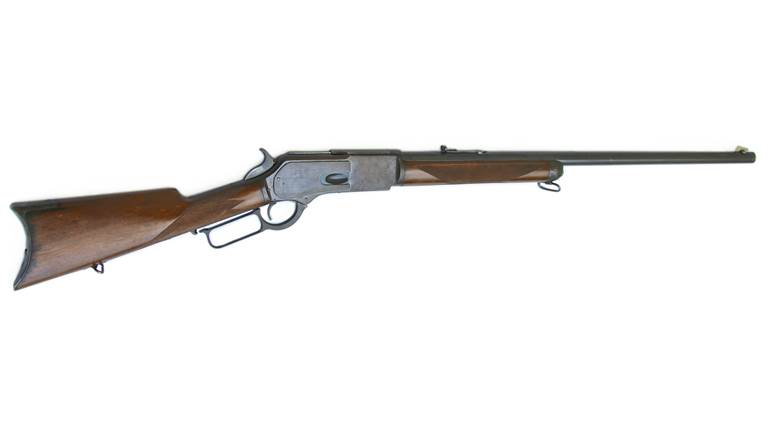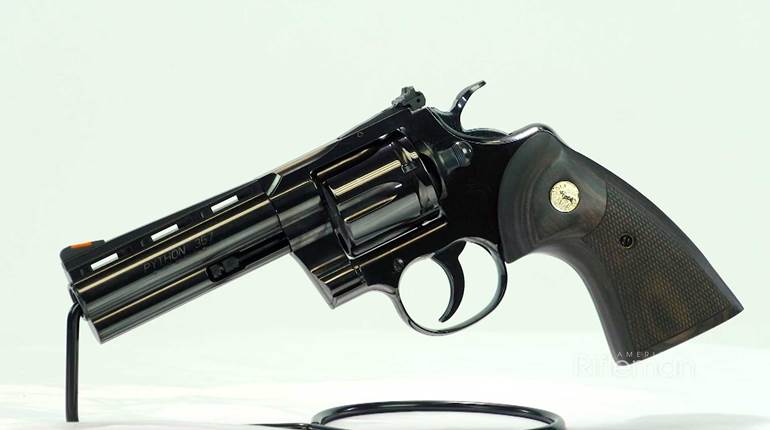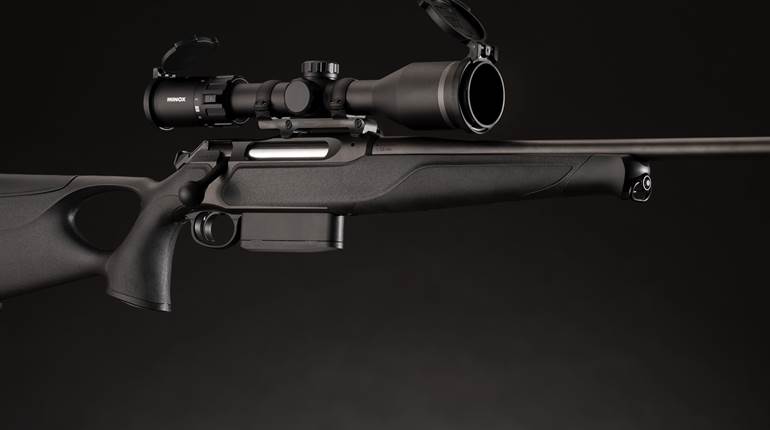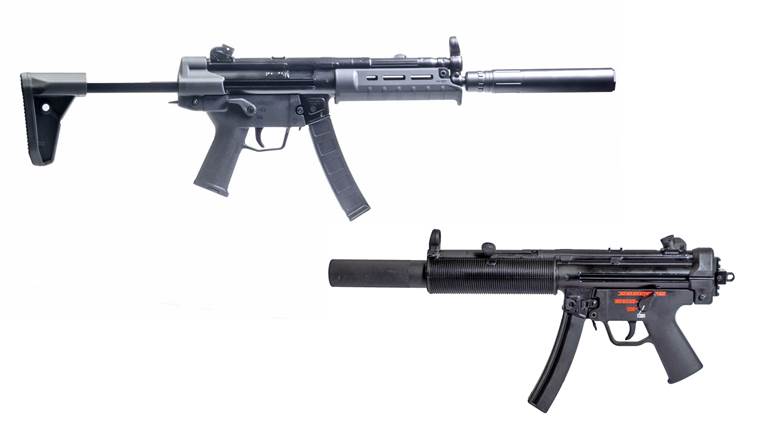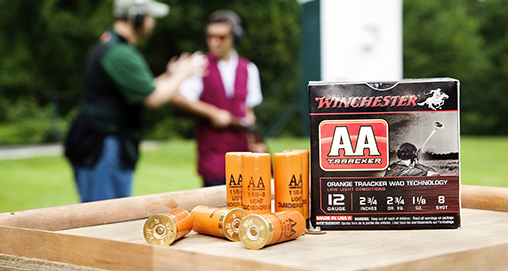
Let’s give Winchester an A for persistence, or perhaps a double-A, since this has to do with shotshells. In what is surely one of the most prolonged R&D projects in the annals of factory-loaded ammunition, the iconic maker earlier this year unveiled the TrAAcker, a new shotshell loading intended as a training aid to help shotgunners see exactly where they are missing. The idea is that a visual cue will help the shooter correct problems with lead-a concept often deemed the most difficult in mastering the shotgun.
Efforts to develop such capability go way back, probably since the advent of high-power rifle tracer rounds during World War I. In 1918, Winchester applied for its first patent for a “flight-marking shot shell,” intending to convey the same corrective benefit as luminescent tracers did for military snipers and machine-gunners. That effort was followed by a stream of would-be solutions containing incendiary components, including rounds used to train aerial gunners during World War II. This wave of development crested in 1966 with Winchester-Western Mark 5 Tracers, a plastic-hulled 12-ga. load that incorporated a pea-sized aluminum bulb containing a pyrotechnic compound ignited by propellant gases.
By all accounts the Tracer’s bright flare could be seen both day and night, but beyond that, questions smoldered. There were complaints about the tracer element’s inability to stay with the shot string, about profuse bore fouling, about short shelf life and about price. There were reports of fields and woods being set on fire, even campfire yarns about birds struck with the stuff falling from the sky aflame. A few years prior to the introduction, the June 1963 edition of The American Rifleman issued a flat warning (“Such tracer pellets would be dangerous to handle and … considerable fire hazard results from the use of any tracer ammunition, which is also illegal in some areas.”) but then the magazine never uttered a word about the actual product. Mark 5 Tracers remained in Winchester catalogs for just a few years and were defunct by the early 1970s.
Meanwhile, the company’s corresponding AA competition line, which utilized similar compression-formed red plastic casings and was introduced in the same time frame, went on to become the world’s most popular shotgun ammunition, particularly on trap and skeet fields. But that didn’t stop Winchester from revisiting the tracer concept and initiating occasional short-lived development efforts.
Other tracer-type shotshells emerged, mostly from custom loaders and often plagued with at least some of the same problems that doomed the Winchester-Western product. While many depended on a pyrotechnic element, other attempts centered on shot pellets that were reflective, fluorescent-coated or treated with a smoking agent. Yet another novel approach involved loading colorful buffer materials intended to produce highly visible, comet-like tails. Most recently (2011), a high-profile, non-incendiary offering came along in the Fiocchi Chemical Tracer. Instead of a burning component, its visible element relies on creative adaptation of the luminous plastic material used in glow-in-the-dark novelties. These alternatives have garnered mixed reviews at best, and the prices-currently running from $2 to $6.50 per round-have been widely panned.
And so when we heard that, after 40 years of off-and-on development, Winchester was again poised to enter the “tracer shotshell” fray, we envisioned everything from neon-coated pellets to colorful dust plumes to glow-stick ride-alongs. We were wrong.
In fact TrAAckers contain the same high-antimony lead shot as found in other AA loads, the same propellant charges and, except for color and markings, the same hulls. “By design,” explained Winchester’s Greg Kosteck, “we created TrAAcker to be almost identical to regular AAs-the same load specs, same recoil, same lead on target. It even feeds on our standard production loaders, which helps to make it cost-effective.” Instead of messing with the recipe that makes AAs a respected world standard, Winchester, working on a cooperative design with Minnesota shotgun innovator Wendell Diller, focused on the load’s other component, the wad. You may be guessing-as we did-whether it’s a wad that glows. Not quite, though that’s closer to the truth. In fact, Winchester did experiment with luminous wads, including one made from the material used to produce kids’ glow sticks.
Instead, the TrAAcker wad is very like a standard AA wad in terms of material, function and design except that it incorporates what Winchester calls a “shot trap,” essentially a tube measuring 0.625-inches long by 0.435 inches in diameter, centrally positioned in the cup around a solid stem. The shot charge is loaded in and around that device, and upon firing, several pellets are trapped. Winchester says that 1/8 ounces of the 11⁄8-ounce charge of No. 8 shot (about 55 pellets) is typically captured, effectively leaving one ounce (414 pellets) for delivery in the pattern. Kosteck said, “Retaining pellets proved to be a better option than molding ballast into the wad or introducing something else that would take up payload space.” The extra weight gives the fired wad more momentum than normal and that allows it to track along with the shot string. In addition, the designers devised notched, helical petals that impart spin as the wad catches the air, and thus allow it to stabilize and fly relatively straight.
To maximize wad visibility, Winchester developed a black option to contrast with clear/bright blue sky, along with an orange version for cloudy days, dusk or against dark backdrops like trees. To prevent confusion, the orange wads are being loaded in matching orange hulls and likewise black in dark gray cases. Factory packaging is marked accordingly. That should make it easy, even in the midst of a clays tourney, to load the optimum color. Hunters may have more difficulty depending on how the birds are flying, however in my testing I found that both wads showed up pretty well regardless of the background conditions.
Luckily, I got to try some of the first TrAAckers released by Winchester, and there was a bit of a learning curve since shotgunners are conditioned to focus on the bird and intuitively disregard the wad.
I test-fired the TrAAckers in multiple sessions on hand- and machine-thrown clays, with shooters of varying experience, with and without coaches. After just a handful of shots our coaches were easily able to observe wad-to-bird positioning and thereby analyze errant shots. Soon the spotters could even anticipate the outcome by watching the wad “pursue” its target in what almost appears like a guided-missile sequence. Our test birds maxed out at about 35 yards, and to that distance the wads remained in very close and consistent proximity to breaking targets. Though the wads lag behind at longer ranges, their flight paths should nonetheless provide a useful indicator, though perhaps less so on sharply angled shots.
In my limited use, TrAAckers proved both fun and informative, clearly answering the “how-did-I-miss” questions. I could easily see just how far we were missing, especially on crossing or dropping birds requiring considerable leads. Most impressive was how it helped my son get the hang of breaking a difficult, over-the-shoulder presentation as is commonly seen in 5-stand, not to mention dove fields and goose pits. By the time that bird entered the strike zone it was dropping and swerving hard left, and he struggled to find the correct lead. The wad made it easy for me to track the wayward shots, and while I could call those misses, that alone didn’t solve the glitch. The breakthrough came when the young man reviewed his shots on video, which we did right there in the field on the camera’s display. After seeing the error with his own eyes, he quickly adjusted and was soon grinding that dirty bird. Based on that, I bet others will also find it very useful to pair TrAAckers with video review.
Moreover, it seems to me that the greatest benefit will come from working in tandem with a coach or partner (or videocam mounted strategically on a tripod), and Winchester obviously agrees, pointedly calling the loading a “training tool” rather than an everyday load in news releases and on the company website. If a shooter makes the effort, he or she can indeed see the wad and watch it in relation to the target, and though I wouldn’t discount the potential value, I’m avoiding that practice and have coached my sons to do so too, because I know our focus needs to be locked in on the bird and our muzzles.
Clearly TrAAcker ammo can eliminate some of the coaching guesswork and will be welcomed. “You’ve given the world something that’s taken me 30 years and 2 million rounds to develop,” wrote Richard Rhode, father of five-time Olympic medalist Kim Rhode, in a letter to Winchester. Even so, certain instructors will shun the new load for fear of distraction or over-complication. And it’s true that revealing where the shooter is missing does not, in itself, correct problems with mount, footwork, cheek weld, swing and flinching. And so as a coaching tool, it will serve as a useful part of the puzzle, though certainly not a cure-all.
Another camp will contend they can always see shot strings just fine without any aid, so why bother? But not all of us have that ability, as is plainly demonstrated by the century-long demand for a product like this. Beyond the obvious benefit for teaching new recruits, old hands may also get on board. Shooters struggling with a nemesis station can now see and work on correcting their inaccuracies. I’m hoping that using TrAAcker in conjunction with a willing partner can help to banish those frustrating Jekyll-and-Hyde days when I’m cleaning some stations but just can’t figure out others.
For the present, TrAAckers come only in 12-gauge, 2.75-dram equivalent loadings with 11⁄8-ounce charges of No. 71/2s or 8s. While there are no definite plans for a 20 gauge or other line extensions just yet, Winchester folks say that possibility certainly exists.
Apart from its insightful performance, this system is darn ingenious because it required nothing more than a new wad. And we can all appreciate that at the ammo counter, paying about $1.25 more per box than standard AA shells. For the prospect of learning how to break more clays and put more birds in the game bag, we expect that’s a price many new and veteran shotgunners will be willing to pay.














